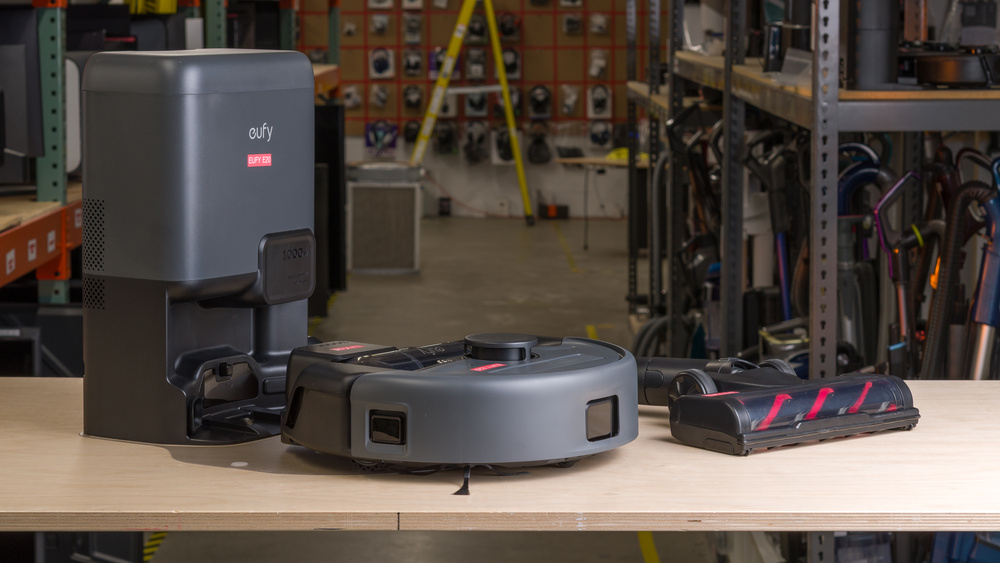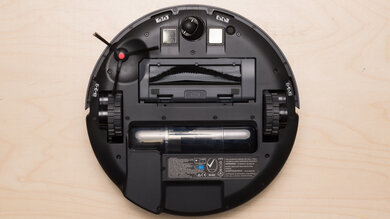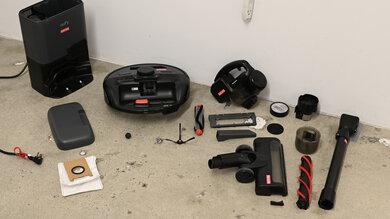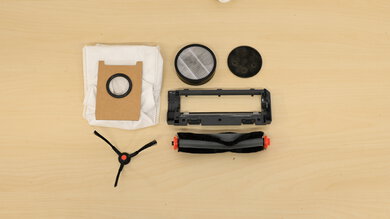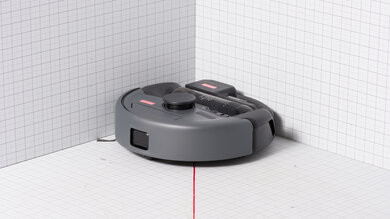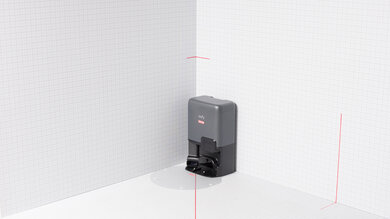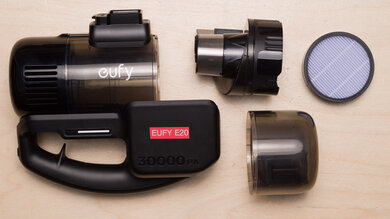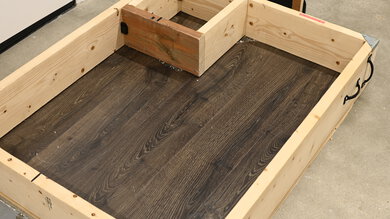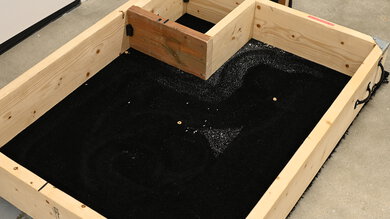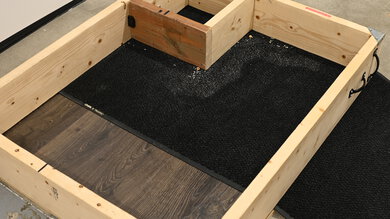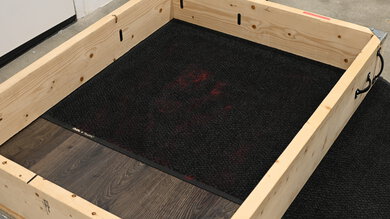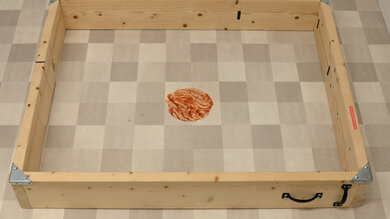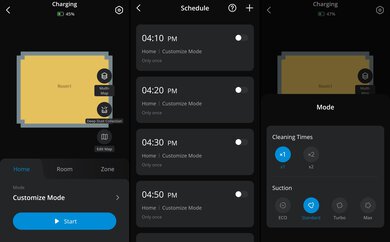The eufy E20 is a 3-in-1 vacuum. You can use it as a robot vacuum or remove its battery, suction motor, and filter components to use it as a handheld with a crevice or combination tool, or a stick with an extendable wand and a floorhead. The robot vacuum features a top-mounted LIDAR sensor for mapping and navigation, and front- and side-mounted LIDAR sensors for object avoidance. It uses a single brushroll with both bristles and rubber vanes and comes with a self-empty docking station.
Our Verdict
The eufy E20 is a fair choice for households with multiple floor surfaces. It's generally better suited to bare floors than carpet, as it does an excellent job handling debris of all kinds on bare floors but leaves a lot of fine material behind on carpets. It's a little better at picking up pet hair, doing a decent job at this task. This robot vacuum is good at avoiding unexpected obstacles left on the floor, but don't expect it to tackle stains since it doesn't have a mopping system.
-
Excellent hard floor pickup.
-
Very good object avoidance system.
-
Leaves a lot of fine material in carpet.
-
Can't clean stains due to the lack of a mopping system.
The eufy robot vacuum 3-in-1 E20 is a reasonable choice for pet owners. It does a satisfactory job picking up pet hair, and its obstacle avoidance system works well enough to prevent it from contacting any pet waste it encounters. However, it leaves deeply embedded pet hair in carpets. Its lack of a mopping system means it won't be able to clean up muddy messes your pet may track in, but at least it's not noisy enough on bare floors to bother your pet.
-
Very good object avoidance system.
-
Fairly quiet on bare floors.
-
Leaves deeply embedded pet hair in carpet.
-
Can't clean stains due to the lack of a mopping system.
The eufy E20 does an excellent job picking up debris from hard floor surfaces. It manages to clean effectively along wall edges and in corners, and its efficient navigation and pathing allows it to cover all hard floor areas thoroughly, vacuuming up nearly all material.
-
Excellent hard floor pickup.
The eufy robot vacuum 3-in-1 E20 is passable for cleaning carpets. It lacks the suction and agitation to pick up fine material, though it does a better job of picking up medium and large debris. It gets bogged down in carpet and occasionally has difficulty moving and navigating, so it sometimes misses portions of carpet.
-
Cleans medium and large debris from carpet.
-
Leaves a lot of fine material in carpet.
The eufy E20 does a decent job of vacuuming up pet hair. Its single bristled brushroll manages to lift pet hair lying on the surface, but can't move pet hair deeply embedded in carpet fibers. It covers the area completely, though.
-
Efficient pathing means it passes over the entire area thoroughly.
-
Leaves deeply embedded pet hair in carpet.
The eufy robot vacuum 3-in-1 E20 is good at handling obstacles. Its object avoidance system is quite effective, allowing it to closely approach obstacles without touching them, then vacuum closely around them. It hardly ever gets stuck on objects and furniture that might trip up a robot vacuum, because its object avoidance system prevents it from getting too close. Unfortunately, it can't clean under low furniture, while shorter robot vacuums can.
-
Very good object avoidance system.
-
Closely cleans around obstacles without touching them.
-
Unable to clean under low furniture.
- 6.9 Multi-Surface Household
- 6.5 Pets
Performance Usages
- 8.5 Debris Pickup: Hard Floor
- 6.2 Debris Pickup: Carpet
- 7.0 Debris Pickup: Pet Hair
- 7.5 Obstacle Handling
Changelog
-
Updated Apr 28, 2025:
We added a link to the eufy E20's performance operated as a stick or handheld vacuum.
- Updated Apr 24, 2025: Review published.
- Updated Apr 17, 2025: Early access published.
- Updated Apr 04, 2025: Our testers have started testing this product.
- Updated Feb 12, 2025: The product has arrived in our lab, and our testers will start evaluating it soon.
Check Price
Differences Between Sizes And Variants
We tested the eufy E20 in Black. There are no other variants. Here's our model's label.
If you come across a different variant, please let us know in the comments.
Compared To Other Robot Vacuums
The eufy E20 is a mid-range vacuum that offers a unique 3-in-1 design, configurable as either a robot vacuum, a stick vacuum, or a handheld vacuum. As a robot vacuum, it's fairly well-rounded, delivering excellent performance on bare floors, decent performance on carpet, and offering a very effective obstacle avoidance system. It offers good battery life and recharges quite quickly. It's not equipped with mopping hardware like its companion, the eufy Omni C20, and it doesn't perform as well on carpet as the similarly priced Roborock S8. However, its performance on bare floors is even better than high-end models like the Roborock Qrevo Pro, and its obstacle avoidance system beats the more sophisticated system found in the Roborock S7 MaxV, or the comparably-priced Shark PowerDetect RV2820ZE. Overall, this robot vacuum is a good choice if you don't need mopping for your household.
The E20 isn't quite as impressive as a stick vacuum, but it makes a decent handheld vacuum. Take a look at our review.
If you'd like to examine other alternatives, check out our recommendations for the best robot vacuums. If you want better carpet pickup performance, take a look at the best robot vacuums for carpet or see how this robot vacuum's hard floor performance compares to the best robot vacuums for hardwood floors. If the E20's handheld vacuum or stick vacuum performance doesn't convince you, find the best stick vacuum or the best handheld vacuum from our recommendations.
The eufy E20 is a slightly better robot vacuum than the eufy Omni C20, despite the C20's mopping feature. The E20 has about the same performance on most floor surfaces (minus the mopping) and also has a self-emptying docking station, but its obstacle avoidance is much better than the C20's. The two robot vacuums are priced pretty similarly, with the E20 trading mopping ability for better obstacle avoidance.
The iRobot Roomba j7/j7+ is a better robot vacuum than the eufy E20. The j7's performance across almost all floor surfaces is a bit better, and it's a bit quieter than the eufy. Both robot vacuums do a great job with obstacle avoidance, although they take very different approaches. The j7's camera-based object avoidance system leaves a large space between the vacuum and the object, also leaving uncleaned areas around obstacles. By contrast, the eufy's LIDAR-based system allows the vacuum to get in very close; it's able to clean more effectively, but occasionally hits objects or gets stuck.
The Roborock S8+ is a better robot vacuum than the eufy E20. The Roborock performs much better on carpet and in picking up pet hair. The S8+ variant comes with a self-emptying docking station like the eufy E20, but at a higher cost than the eufy. The Roborock S8/S8+ has mopping ability, which the eufy lacks. However, the eufy E20 is a little better on bare floors, and its obstacle avoidance is much better than the Roborock S8.
The eufy E20 and the Shark PowerDetect RV2820ZE are pretty evenly matched, with the eufy having a slight advantage in performance over the Shark on most floor surfaces. The Shark adds mopping, though it's mostly ineffective, and both have self-emptying docking stations. But the eufy's obstacle avoidance system is clearly better than Shark's flagship.
Test Results
The eufy E20's build quality is decent overall. The body is entirely plastic in a matte finish, with rubber wheels, a silicone tube leading to the floating brush roll chamber, and synthetic fibers on the side brush and brushroll. The battery, suction motor, and filter components form the base of the handheld vacuum. This has higher quality construction than the rest of the robot vacuum, with a glossy finish and a translucent filter and dustbin. However, the plastic gets scratched and marked very easily and quickly from normal use.
The frame of the robot vacuum feels sturdy, and although the bumper seems thin and cheap, it doesn't feel like it would be fragile enough to break.
The brushroll guard is very easy to remove, and pressing a prominent red quick release button effortlessly removes the handheld vacuum component.
The robot vacuum is easy to place on the dock for charging or self-emptying, and the docking station's dust bag slides in and out smoothly.
The eufy E20 3-in-1 has a low number of parts, with most easy to access and maintain, though a few can be a little tricky.
The brushroll tends to get wrapped up with hair, with more hair gathering at the ends. The docking station's self-empty cycle removes some of the hair, but you will still need to regularly remove the brushroll and clean it to remove all the hair. You have to remove the end bearings to pull out the brushroll for cleaning. The side brush can be installed and removed without tools, and keeps itself fairly clean, with only a few strands of hair needing manual removal. The omnidirectional front wheel needs to be pried out with a tool so that you can remove any hair tangled around it, but it just snaps right back in for reinstallation.
You can manually empty the dustbin by removing the handheld component from the robot vacuum using the large red quick release button, then rotating the dustbin to unlatch it. The self-empty docking station does a good job of keeping the dustbin clean, so you shouldn't have to manually clean it very often. With the handheld component removed from the robot vacuum, it's easy to access and clean the washable filter with water, though you should allow the filter to dry thoroughly before reinstalling it. The Jet Cyclone filter's separate dirt compartment fills up quite quickly, and it's a bit difficult to clean out this tiny part.
Fortunately, docking station maintenance is very easy. Only the dirt bag needs to be replaced, and it's easy to access and remove. Once released, the bag seals itself, making the replacement process clean and hygienic.
The eufy E20 has high recurring costs, with many parts that must be replaced frequently. You can buy parts from eufy's website.
- Anti-Bacterial Dust Bag: This must be replaced when full or every 75 days. You can buy a three pack on eufy's website.
- High Performance Filter Set: This should be replaced every six months or when worn. A replacement filter set is available on eufy's website.
- Brushroll: You should replace the brushroll every six months or when it shows visible signs of wear. It's available on eufy's website; be sure to purchase the brushroll for the robot vacuum and not the handheld vacuum floorhead brushroll.
- Side Brush: This wears quicker than the brushroll and should be replaced every three months or when it shows signs of wear. You can purchase this in packs of two on eufy's website.
- Brush Guard: This part surrounds and retains the brushroll and should be replaced every six months or when worn. A replacement is on eufy's website.
You can also buy all these parts in an Accessories Kit, which includes enough parts to last six months and contains:
- 3x dust bags
- 2x filter sets
- 1x brushroll
- 2x side brushes
- 1x brush guard
The cylindrical dustbin is on the small side of average for a robot vacuum. The eufy E20 robot vacuum makes frequent use of the dock's self-emptying capability. It won't be able to vacuum very long without having to go back to the dock to self-empty. The self-emptying is on a timer, and there's no visual or app indicator to show when the dustbin is full. You'll have to set the timing yourself based on the typical debris level in your home.
The docking station only has self-emptying capability since the robot vacuum lacks a mopping system. While the disposable bags have an advertised capacity of 3 L, in practice, they accommodate much less. This is due to the small internal volume of the docking station's dirt compartment. When the dust bag is full, the docking station will no longer be able to suck debris into the bag. This material accumulates in the chute and not the bag, and spills onto the floor once the robot vacuum moves away from the dock.
Robot vacuum components:
- eufy E20 robot vacuum body
- Brushroll
- Brushroll guard
- Side brush
Handheld vacuum components attaching into robot vacuum body:
- Handheld vacuum body
- High Performance Filter
- Jet Cyclone filter assembly
- Dustbin
Docking station components:
- Docking station
- Docking station lid
- Docking station traction mat
- Dust bag
- Power cable
Handheld vacuum components:
- Floorhead
- Floorhead brushroll
- Floorhead brushroll retainer
- Crevice tool
- Combination tool
- Extendable wand
Guides:
- Quick Start Guide
- Safety information
While the eufy E20 has remarkable minimum and maximum battery life and should easily be capable of cleaning even large rooms on a single charge, its standout feature is its impressively short recharge time.
Once it reaches 10% battery charge, the robot vacuum will return to the dock for recharging. eufy states that on a charge, the robot vacuum should clean 1500 square feet.
As a midrange model, the eufy E20 has a few quality-of-life features. You can adjust its suction setting using the app or by a button on top of the robot vacuum, choosing between Eco, Standard, Turbo, and Max. You can override this manual setting by selecting BoostIQ in the app, which will automatically increase suction once the robot vacuum encounters carpet. An LED bar graph on the handheld component's handle shows the selected suction mode.
This LED bar also shows the state of the battery when the robot vacuum is in operation, giving seven indications in steady green, and steady or flashing yellow or red. The bar can also indicate when the robot vacuum is charging, and shows error, pairing, or resetting states.
The Mode button sets Home Mode or Room Mode. Home Mode cleans your entire home, while Room Mode cleans rooms in a certain order, or just one room, though you can also set zones in the app to clean across the entire floor plan. Once the Mode is set, the Start/Stop button starts a cleaning task if one hasn't already been initiated on a schedule. You can select the suction level and specify the number of cleaning cycles for each Mode.
This robot vacuum has excellent performance on hard floors. It picks up nearly all fine, medium, and large debris, leaving only a tiny bit in corners. When it's positioning itself, it does wander out into the debris and spin in place, with its side brush scattering material around, but it goes back and thoroughly cleans the entire area.
This vacuum does an adequate job on high-pile carpets. It can handle medium and large debris fairly well, but it has trouble picking up fine material, especially along edges. While its pathing is usually quite good, it misses small patches in tight spaces.
The eufy E20 delivers mediocre performance on low-pile carpets. It leaves more fine material on the right of its path since the suction isn't evenly distributed across its brushroll slot, with more suction on the left than on the right. It positions itself so that wall edges and corners are on its right, near its side brush and side-mounted LIDAR object detection sensor. But this is where its suction is weakest, so it leaves a lot of fine debris along edges and corners.
Its heavy wheels have deep teeth and are geared quite high, so they don't travel very well on stiffer, low-pile carpet. This may cause erratic movement on carpet where the vacuum has trouble traveling in a straight line, repeatedly making wide turns. This sometimes leads to pathing issues where the vacuum misses large sections of carpet.
The vacuum's airflow is good, about typical for a robot vacuum.
The eufy E20 is fairly quiet on bare floors and won't cause significant disruption in your home. It's louder on bare carpet if you've turned on BoostIQ, which automatically ramps the vacuum up to its most powerful setting once it encounters carpet. But you should still be able to hear a conversation and watch TV with the robot vacuum working on carpets.
This vacuum does a decent job of adapting to larger obstacles. It covers a room well and usually doesn't get itself stuck. But its LIDAR sensor is so high that it can't clean under some furniture—as it tries, it repeatedly rams the LIDAR sensor tower into the bottom of the furniture with a lot of force.
A floor-length mirror may cause problems with mapping, but the vacuum's real-time object avoidance is good enough to make it avoid such mirrors entirely.
This object avoidance system operates well enough to recognize rug tassels as obstacles to avoid, and it's almost good enough to allow you to leave rugs with tassels on the floor. However, the vacuum still occasionally gets tangled up in rug tassels. It usually avoids tall obstacles entirely, but this means it often doesn't clean under tall obstacles with legs like coat racks.
The eufy E20's obstacle avoidance is very good. In addition to its wide-angle room mapping LIDAR sensor on the top of the robot vacuum, it has a front-mounted LIDAR sensor for obstacle avoidance and another on the right side. When its front-mounted sensor detects an obstacle, the vacuum will stop and turn to the left, tracking the object with its right-mounted sensor and maintaining a close distance while it vacuums around the obstacle in a clockwise circle. It can completely clean very close to an obstacle without ever touching it.
This obstacle avoidance technique is usually effective around most household obstacles, allowing it to avoid shoes, socks, pet bowls, cables, and even pet waste—most of the time. The user manual advises you to remove cords prior to cleaning. While the vacuum usually manages to avoid cords in practice, when it isn't successful, they can easily get tangled in the sidebrush and brushroll.
This vacuum's LIDAR sensor tower sits quite high, giving the eufy E20 poor height clearance. The robot vacuum hits low obstacles quite hard.
The eufy E20 climbs short and medium height thresholds well, but lacks specialized hardware to climb 1" tall thresholds. These are low enough not to be detected by its body-mounted LIDAR sensors but tall enough to trigger its collision bumper, so it doesn't attempt to go any further.
The eufy E20 does a poor job of sealing in particles. It blows fine particles out of its exhaust port and slowly discharges all the fine particles circulating in its filter system as well.
Without the app, the eufy E20 has basic but effective physical automation features using only four buttons: three located on the robot vacuum body and one on the handheld vacuum handle. The buttons respond to short or long presses and combinations of buttons held simultaneously provide more control.
The Power button located on the handheld vacuum handle turns the vacuum on, and will turn it off if held down for 10 seconds. The Start button starts cleaning or pauses cleaning if the robot vacuum is already in a cleaning task. The Suction Mode button selects the suction mode, cycling between Eco, Standard, Turbo, or Max, and also shows the battery level if held for three seconds. The Recharge button sends the robot vacuum back to the station for recharging. Holding this button for three seconds sends the vacuum back to the docking station to empty its dustbin and clean its brushroll.
Holding the Recharge and Suction Mode buttons simultaneously for three seconds starts Wi-Fi pairing, and holding these buttons for 10 seconds restores the factory settings. Pressing and holding both the Recharge and Start buttons for three seconds toggles the child lock, which deactivates all other buttons.
The full-featured eufy Clean app offers fine-grained control of every setting, allowing you to customize nearly every aspect of the eufy E20's operation. See this video walkthrough of the app.
To create a map, you can select Fast Mapping, where the robot vacuum goes through your home using its LIDAR sensor, or Clean + Mapping, where it maps while cleaning simultaneously. You can see the robot vacuum's path in real time when it's mapping. Once a map is created, you can create another map on another level of your home and add no-go zones or virtual walls. You can also divide, merge, hide, or name rooms as well as add carpeted sections.
You can set up to 10 schedules for vacuuming, and repeat a schedule on certain days. On each schedule, you can set the suction level and the number of cycles for each cleaning task, and also select a certain room, zone or the entire house for scheduled cleaning events.
You can set the auto-emptying frequency of the robot vacuum from every 15 minutes of cleaning to every 60 minutes. You can set the auto-emptying cleaning mode from Normal to Deep. You can also set whether the robot vacuum will auto-empty after every use of the built-in handheld vacuum.
The app tracks cleaning history as well, showing the total number of times the robot vacuum has operated, the total area cleaned, and the total operating time of the vacuum. There's also data on individual operations: a map of its path, the area, the cleaning time, a timestamp, and the robot vacuum's status at the end of an operation. You can also track the remaining lifetime of each replaceable component.
You can toggle the BoostIQ setting on or off, which will automatically increase the suction of the robot vacuum when it encounters carpet, though this reduces battery life. There are manual controls for initiating cleaning, returning the robot vacuum to the docking station, and for moving the vacuum in a particular direction.
So that it won't disturb you, the robot vacuum can be set to No Resume, meaning it will not resume cleaning after it recharges, or Silent Running, where it keeps its suction as low as possible to minimize noise. You can also set the Child Lock to deactivate the vacuum's physical buttons. The app allows you to set the measured units. There is also Find My Robot, which you can select if the vacuum is lost.
The only feature you can't alter is the obstacle avoidance setting. The robot vacuum also doesn't mark obstacles on the map, even though it does a good job of recognizing and avoiding them.
